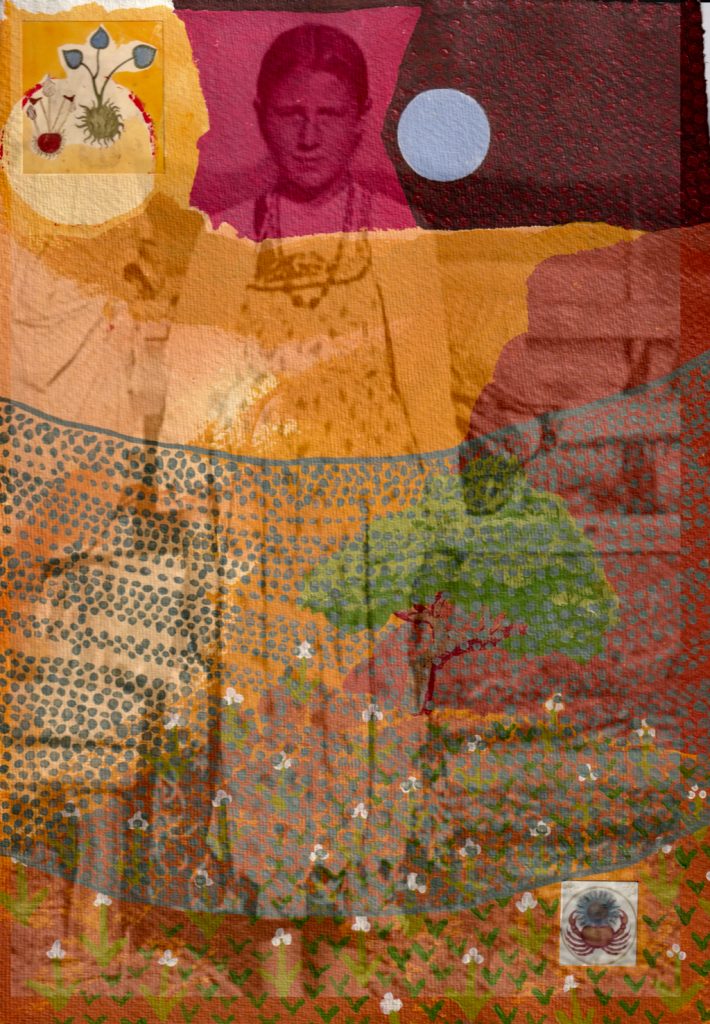
To ignore, and so forget, one’s earliest historical records is to be as deprived as to lose one’s memory. When that happens, the sufferer cannot fully understand and cope with the present.
Kathleen Herbert (1997) Peace-Weavers & Shield-Maidens: Women in Early English Society Swaffham, Norfolk, Anglo-Saxon Books p. 31.
In Beowulf Queen Wealtheow, a peace-weaver and ‘devout follower of the old religion’ uses the skills of diplomacy, counselling and magic simultaneously. The all-important link between them being that: ‘if you say something the right way, it will come true’. Speaking with informed tact and care led to “magic” happening![1]This suggests another, enlarged, understanding of creative inspiration; one more extended, more collectively oriented, and more inclusive than is usually understood and something highly relevant to communally-oriented forms of contemporary art.
Traditionally (male) poets’ muses were the demi-goddesses Calliope, Erato and Polyhymnia (depending on the type of poetry). In 1990 Nuala Ní Dhomhnaill found herself preoccupied with the demands of a distinctly male muse, ‘this shadow black man who is dancing’, the “black prince” or, in Madbh Mc Guckian’s English translation, ‘The Ebony Adonis’.[1] (Again a figure who is echoed in statements repeated by Wilby). The poem makes clear that Ní Dhomhnaill is concerned with the fullness of her own humanity as a young woman, not with anything “sub-human”. Elisabeth Bronfen claims that women’s response to the need for poetic inspiration is to create ‘a dead woman’ as muse, since any writing by women ‘is writing out of death’, given women’s historical and culturally construction ‘as absent and mute, and thus, dead’.[2] Ní Dhomhnaill reconfigures this claim. She identifies ‘the lios or “faery fort”’ – which she describes elsewhere in terms of an saol eile, the “otherworld” – as the site of poetic inspiration, presenting poetry’s purpose as being to bring ‘stuff from that other world into this world’.[3] An “other world” in which what is undervalued, unacknowledged, dismissed, repressed or lost remains present.
Ní Dhomhnaill’s lios echoes the worldview of Early Modern cunning folk who regularly referred to their familiars as either ‘fairies’ (often understood at that time as the ‘spirits of the dead’), or as a ‘being connected to the fairies’.[4] The accused in “witch” trials were marginalised individuals, “absent and mute” in relation to authority, who found a voice and a social role through a relationship with familiars understood variously as fairies, ‘”angles”, “saints”, “sprites”, “imps”… and so on’.[5] Perhaps, thinking of inspiration, we might do well to pay attention to Paula Meehan when she writes: ‘poetry is what I’m here to do. And my granny and my mother, both of whom are dead, they won’t let me alone. They won’t let me stop’.[6] Perhaps in some important sense we are “spoken through” by something larger than the ego, and by acknowledging this can enlarge our sense of care and attention?
[1] Nuala Ní Dhomhnaill (2005) op. cit. pp. 56, 61, 62, 106, etc.
[2] Quoted in Cary A. Shay (2014) Of Mermaids and Others. An Introduction to the Poetry of Nuala Ní Dhomhnaill Bern, Peter Lang AG, p. 190.
[3] Nuala Ní Dhomhnaill in Rebecca E. Wilson and Gillian Somerville-Arjat (eds) (1990) op. cit. pp. 149-150.
[4] The etymology of duende relates it back to ‘duen de casa, “lord of the house”, which in Spanish folklore is ‘an imp, a hobgoblin’, but may also be understood as a ghost or trance. See Edward Hersch (2002) op. cit. pp. 9-10.
[5] Emma Wilby (2005) Cunning Folk and Familiar Spirits: Shamanistic Visionary Traditions in Early Modern British Witchcraft and Magic Eastbourne, Sussex Academic Press p. 57.
[6] Paula Meehan in Theo Dorgan (1992) ‘An Interview with Paula Meehan’ Colby Quarterly Vol. 28, Issue 4 December 1992 p. 5.
[1] Kathleen Herbert (1997) Peace-Weavers & Shield-Maidens: Women in Early English Society Swaffham, Norfolk, Anglo-Saxon Books p. 31.